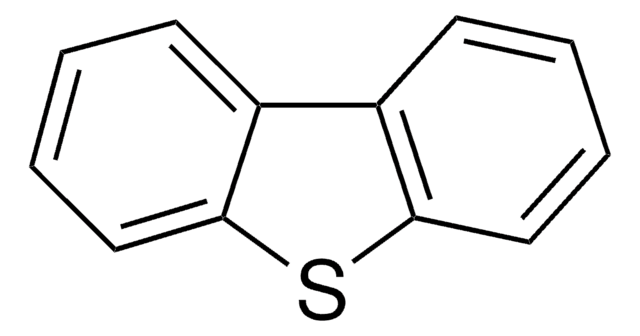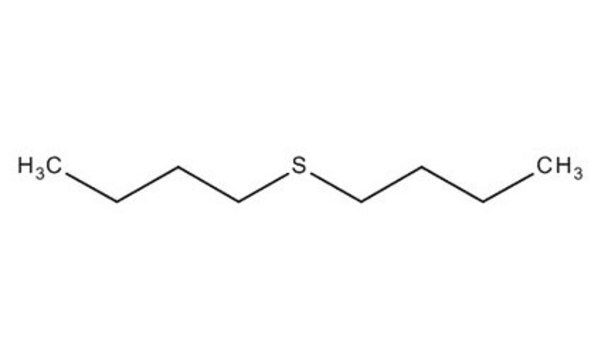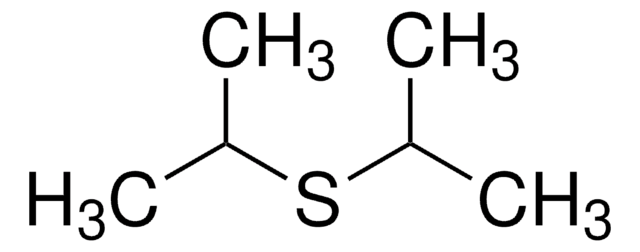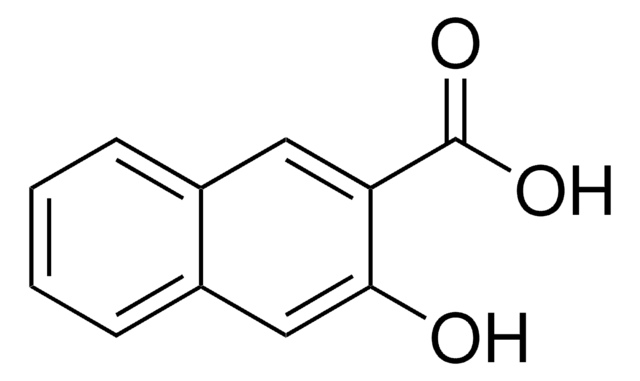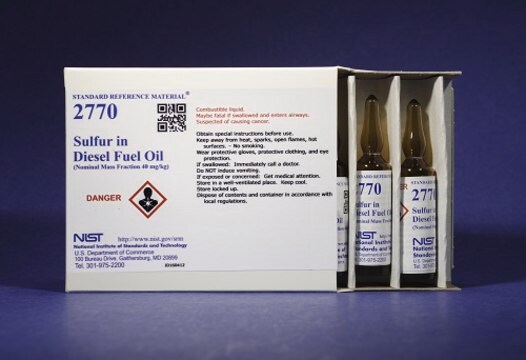51491
Dibutyl sulfide
≥98.0% (GC)
Synonym(s):
1,1′-Thiobisbutane, Butyl sulfide, NSC 8460
Sign Into View Organizational & Contract Pricing
All Photos(3)
About This Item
Linear Formula:
CH3(CH2)3S(CH2)3CH3
CAS Number:
Molecular Weight:
146.29
Beilstein:
1732829
EC Number:
MDL number:
UNSPSC Code:
12352100
PubChem Substance ID:
NACRES:
NA.22
Assay:
≥98.0% (GC)
Recommended Products
vapor density
5.07 (vs air)
vapor pressure
5.17 mmHg ( 37.7 °C)
Assay
≥98.0% (GC)
refractive index
n20/D 1.452 (lit.)
n20/D 1.453
bp
188-189 °C (lit.)
mp
−76 °C (lit.)
density
0.838 g/mL at 25 °C (lit.)
functional group
thioether
SMILES string
CCCCSCCCC
InChI
1S/C8H18S/c1-3-5-7-9-8-6-4-2/h3-8H2,1-2H3
InChI key
HTIRHQRTDBPHNZ-UHFFFAOYSA-N
Looking for similar products? Visit Product Comparison Guide
Related Categories
General description
Butyl sulfide is a volatile organic sulfur compound that is used as an organic building block in chemical synthesis. It is used to prepare dibutyl sulfoxide (DBSO) via oxidation reaction. DBSO is used as a valuable organic solvent for the extraction of zirconium, palladium, platinum, and gold.
Application
- Environmental Odor Diagnostics: Dibutyl sulfide was utilized in developing a diagnostic method for complex odor issues in micro-polluted source water, highlighting its role in environmental monitoring and pollution control (Guo et al., 2021).
- Surface Chemistry Investigations: The adsorption and manipulation of dibutyl sulfide on copper surfaces were studied, providing insights into its interactions at the molecular level (Jensen et al., 2007).
- Biosensor Development for Chemical Warfare Detection: Dibutyl sulfide′s effects were explored in the context of stand-off tissue-based biosensors for detecting chemical warfare agents, utilizing photosynthetic fluorescence induction, it is crucial in constructing the inertial forces of launching or dropping into suspected danger zones and, with encrypted telecommunication data transmission (Sanders et al., 2001).
Storage Class Code
10 - Combustible liquids
WGK
WGK 2
Flash Point(F)
170.6 °F - closed cup
Flash Point(C)
77 °C - closed cup
Personal Protective Equipment
dust mask type N95 (US), Eyeshields, Gloves
Choose from one of the most recent versions:
Already Own This Product?
Find documentation for the products that you have recently purchased in the Document Library.
Customers Also Viewed
Electron transfer and singlet oxygen mechanisms in the photooxygenation of dibutyl sulfide and thioanisole in MeCN sensitized by N-methylquinolinium tetrafluoborate and 9, 10-dicyanoanthracene. The probable involvement of a thiadioxirane intermediate in electron transfer photooxygenations.
Baciocchi E, et al.
Journal of the American Chemical Society, 125(52), 16444-16454 (2003)
Effect of irradiation intensity on rate and selectivity of photosensitized oxidation of dibutyl sulfide over C70 fullerene.
Arsentyev AV, et al.
High Energy Chemistry, 49(3), 167-172 (2015)
Dithiolane-Directed Tandem Oxidation/1, 2-Benzyl Migration of Tetramic Acids under Ambient Conditions.
Li Y, et al.
Advanced Synthesis & Catalysis, 354(9), 1712-1716 (2012)
Revisiting the Zincke disulfide reaction for the post-polymerization functionalization of unsaturated polyolefins.
Dunst A, et al.
Polymer, 55(2), 5557-5560 (2014)
Adsorption, interaction, and manipulation of dibutyl sulfide on Cu {111}.
Jensen SC, et al.
ACS Nano, 1(1), 22-29 (2007)
Our team of scientists has experience in all areas of research including Life Science, Material Science, Chemical Synthesis, Chromatography, Analytical and many others.
Contact Technical Service
